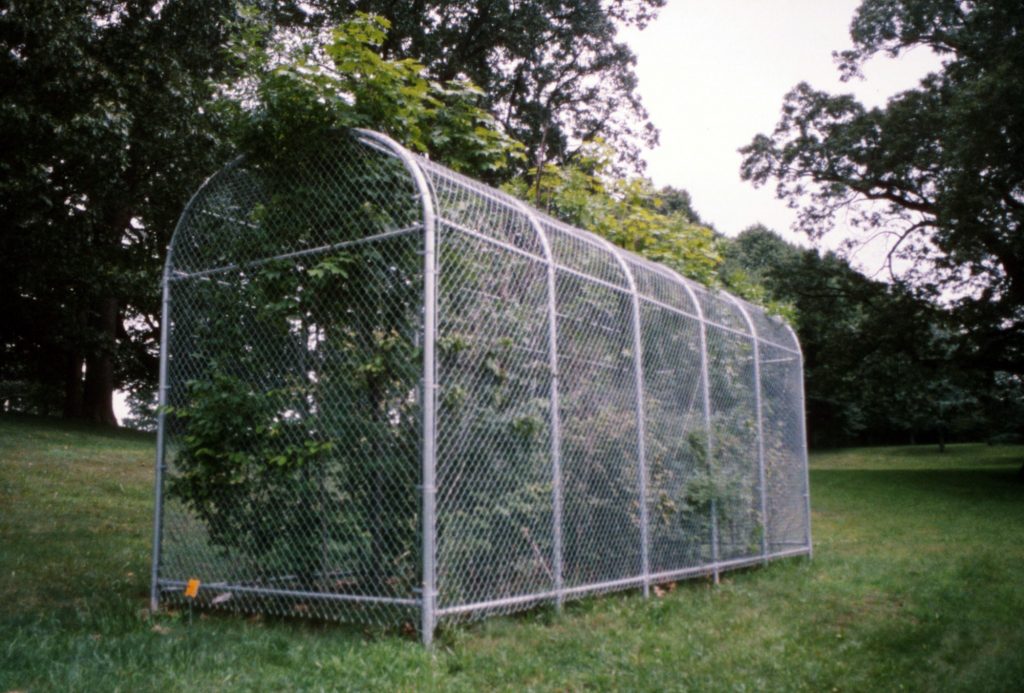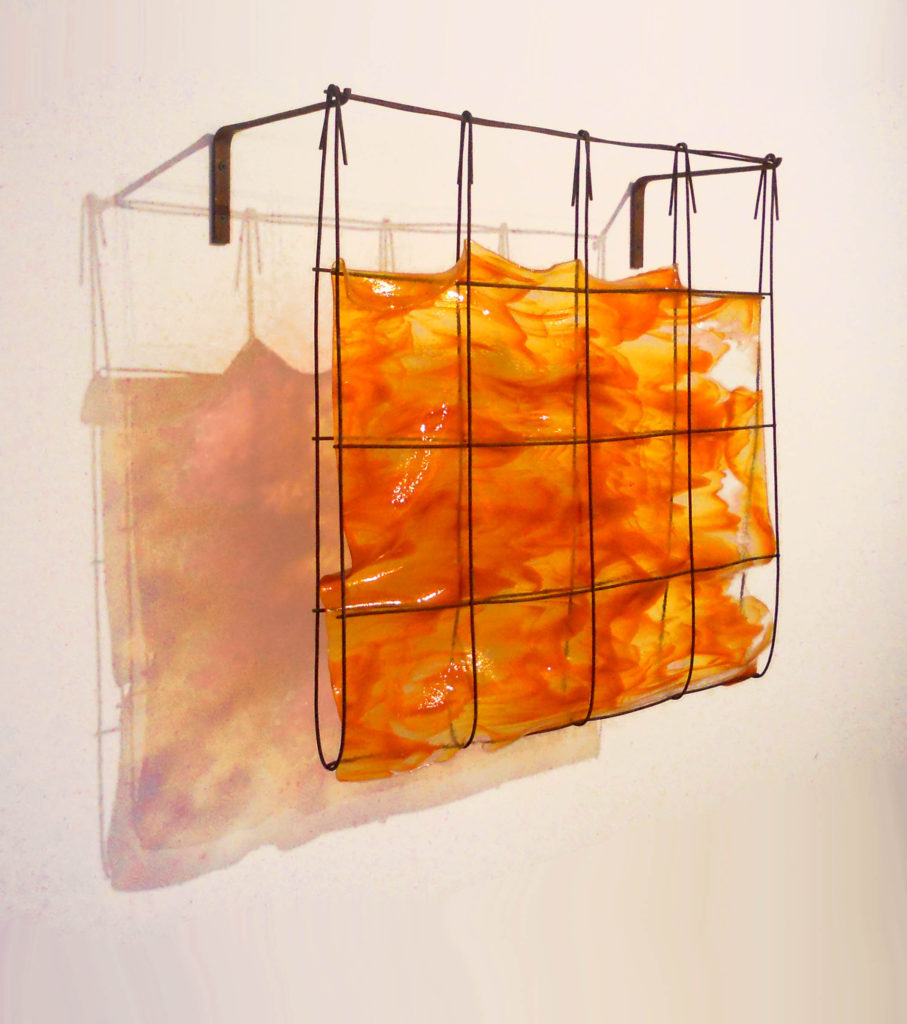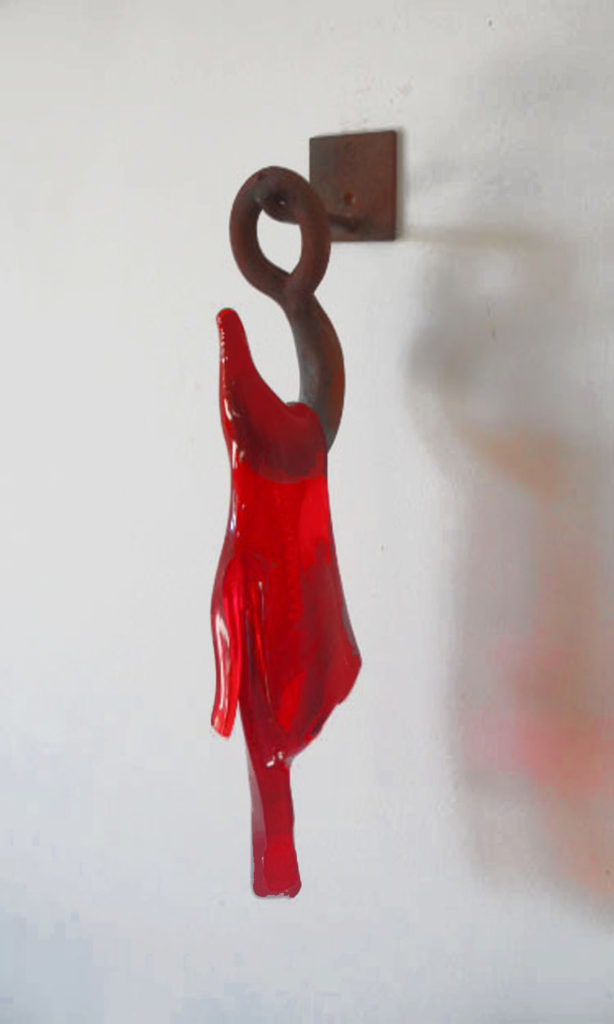Fire Drip

Rome, Italy 1975
Opposites
A work about opposites, water vs. fire. In 1974 the unimaginable became real when fracking caused the water from home taps to ignite.
Getting a Good Look

Providence, RI 1972
Myopic Vision
Perfect Pedestal for a Car

Murray State University, Murray, KY 1977
Comment on traditional sculpture
I was teaching sculpture at the University of RI although it was a studio class, I also talked about the development of sculptural ideas. When I was explaining Rodin’s Burghers of Calais and how Rodin decided to go against tradition and put the figures directly on the ground, not on plinths or sculpture stands. I started thinking about cars, how they are the sculptures of our time. They are an amazing composite of more than a 1,000 different carefully crafted pieces combined into one machine. I decided the perfect pedestal would be a water puddle.
At Murray State University I organized a performance. We dug a hole, filled it with water and put a car in it. Students volunteered to be the performer, or driver. It was a surprise to them how aggressive and angry the passersby were. The anger was similar to what Chris Burden said about his performance work “Five Day Locker Piece,” he said the students were combative and scary in his helpless, vulnerable position locked in a school locker and would poke things at him.
In Memory Of

Fine Arts Gallery Murray State University, Murray KY 1977
Memory and Healing
I was invited to do a show at Murray State’s Fine Arts Gallery, I was on the phone asking about the size of the room, and where the electrical outlets were. When they said every 10 feet in a grid pattern, I immediately had a vision of the show in every detail-- the poster, the title, and the way it would look.
I put college dorm-type gooseneck lamps at every outlet, realizing the space would look like a graveyard as well as an airport landing field. I wanted to put mementoes of the dead in small plastic sleeves under each lamp. I asked friends whether they had someone they wanted to remember. They all had such different ways to honor their dead.
Mike Fink, an art historian at RISD (Rhode Island School of Design), came by my house with his baby in his arms. I asked whether he had someone to remember, he pulled a pair of glasses from his shirt pocket. “These are my mother’s,” he said. “She died several years ago.”
I asked my friend Ed Koren, the cartoonist. He said yes and went to his drafting table. From his pencils and pens, he pulled out dental tools. I said, “Oh, do you use these in your work?” He said no, his father had been a dentist and he liked to keep his tools close at hand.
Just the Two of Us





University of Rhode Island, Kingston, RI 1997
Duality and loneliness
‘Just the Two of Us’ is experienced by walking into a building, down a hall, then into a large gallery room. In the middle of the room is a cube where a slightly smaller than average door is brightly lit. Beside the door is the text ‘if open enter alone and shut door’. As soon as you walk into the cube (inside a room inside a building) you feel as if you’ve stepped into the middle of the forest. You are in a golden brown canvass tent, there are shadows of tree branches moving above you, the tent is rippling as if in a slight breeze, it smells like the forest and the floor of the tent is on an uneven dirt ground, which you smell also.
There is one sleeping bag on the floor and a small radio with a soulful song playing “Just the Two of Us as happy as can be, just the two of us the way it ought to be, just the two of us, just the two of us…..” then it repeats. The jazz signer told me how sad the song made her feel. On the walls of the swaying tent are identical post card size images taped to the walls two by two of the dual images I took. In the middle of the tent is a single tent pole. You feel very alone and safe, far from other people. You come to understand that duality is the logic of our world. We have two arms and feet, our cars are made in our body image with two headlights. We have up and down, hot and cold. This is our understanding of the world and our place in it is to mate with the other. Our survival as a species demands that.
If you take a guided tour through the Newport mansions, the guide explains that everything in the house had to be symmetrical. If there was only one door into a room, they would create a false door to maintain the summitry.
With ‘Just the Two of Us’ I was mourning the loss of my marriage, a father for my two children. I noticed that when I looked at two stones flanking a driveway or two mailboxes side by side that it made me feel lonely. I started collecting images of things that were two by two, haystacks, entrances to school, street lamps, my daughters pony tails, a car’s headlights among many others. These were the images I used in post card size taped to the walls of the tent.
Keep Off Sidewalk
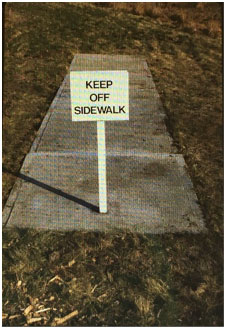
University of Rhode Island, Kingston, RI 1976
Rules and habits
Where I grew up, everyone walked, in the country, in the towns, and in the cities. When I moved back to the United States to go to the Rhode Island School of Design in Providence, I was surprised no one used the sidewalks. I saw so many signs saying, “Keep off the Grass,” and these were a surprise to me as well. It was logical then for me to put a sidewalk—looking old, cracked, and uneven, as they were in Providence—in the middle of grass and ask people to keep off it.
Garbage for your Eye
Greenfield Community College, Greenfield MA 1976
Is about activity and the beauty found in chance gestures
Hardu Keck my former husband and a terrific teacher, although not a teacher of mine, used to say –look at the byproduct of what you are doing, the activities you are engaged in. So I started collecting the visual results of activities of mine. Many of these I brought with me to the exhibition space.
There were students there ready to help so I would say –cut this board into three parts. When they were done, I would say perfect, that’s what I want—so I would include the results of their activity into the show.
Within this show was a tribute or memorial to a friend who had just died in his studio because he drilled into an electrical line. His wife said he has just gotten an artist’s grant and was fixing up his studio.
Spilled Milk

AnyArt Gallery, Warren RI 1977
The separation of pain and beauty--crocodile tears and soap opera of the mind
In this exhibition, you entered alone and shut the door behind you. An outline on the floor indicated where you could walk, with a small circle at the end of the path where you could sit down. A friend told me that she meditated there.
The soundtrack was of a woman crying--loud, angry, and hurt. Broken glass shards stuck straight up all over the floor, so close that you could not leave the path without hurting yourself. Bright lights skimmed along the floor, hitting the glass and creating incredibly beautiful reflections on the walls.
It was impossible to hear the crying without feeling hurt yourself. In order to deal with the pain, you started “living” in your eyes. Then the visual beauty superseded your sorrow. I think this is how artists in particular cope with hardships-- they start living through their eyes, and beauty washes away pain. The title refers to the adage, “Don’t cry over spilled milk,” which is telling you to move on. Pain passes in the beauty of life and in our natural world.
Bottoms Up for Provincetown


Provincetown Fine Arts Center, Provincetown MA 1976
Celebration of gay men
Provincetown was so delightfully gay when I was there for the summers of 1976 and 1977. It was also a party and drinking town, as well as an artist’s mecca. I decided to celebrate the spirit of the place by making “Bottoms Up.” I made five plaster bottoms, neither male nor female but idealized. I took these into bars and placed them on bar stools, and outdoors on sand dunes, then took pictures. In one bar a rather distinguished man said, he could have me murdered if I took his picture, but most of the men took the butts in a spirit of fun and acceptance.
Dead End


Providence Park Department, Providence RI 1999
Customs and habits
I noticed that people cover up death and dying in American even when actually burying their dead. In Austria, where I grew up, we spend lots of time in the grave yards, at Christmas the town will turn out for mid-night mass and a walk among the graves to honor their dead and to greet living friends, it’s very festive.
In the States the graves are often completely covered in cloth or AstroTurf and no one actual sees the coffin being lowered into the ground. It’s so antiseptic. I wanted to dig a real grave—exactly six feet down--and dug by a real grave digger. At the edge of the woods I put up a real road sign saying ‘Dead End’. I thought people might notice the absurdity of that sign, as there are no dead end in the woods. Then along the path they would see an actual 6 foot down deep grave.
After the exhibition was over my children and I went to fill in the grave. We were having lots of fun shoveling in the dirt and climbing and sliding all around. A very old man walked by alone and ask us what we were doing. I suddenly felt very bad thinking he had just lost his life’s partner. My children happily answered ‘Oh this is a grave my Mom dug and we’re filling it up now’. The girls were giggling and laughing and the old man who at first looked stricken started laughing with them.
Containment Field
Providence, Rhode Island 1996
Denying Youth
In Rhode Island, I noticed that correction houses for young offenders had a very specific type of fence you could not climb. That fence was only for those locations. Our penal system is so detrimental to young people—not enough programs or education for them, no respect or honor shown them. In Norway adult offenders actually live in houses doing their own cooking, using knives, having their own rooms, with just two guards.
I wanted to show that the living spirit of young people will not be contained. I bought the same fence and made a little house with the curved part slanted inwards and a small space above so the vegetation and trees I planted inside could come pouring out. No matter how hard someone tries to kill the human spirit, it will fight to be free.
Ode to Fiddler

University of Maryland, College Park
MFA thesis exhibition, Washington DC 1987
Family Violence
A prominent government official in Washington who was considered so proper and upright was beating his wife and children. It was a big scandal; no one had found out for a long time because there was no noise, no screaming or crying or shouting. Family violence is often very quiet and secret.
I stood several 12-foot steel pipes upright; they were about 12 inches wide. In the top section of each, I cut openings. There was light within the columns and jutting out from the openings or “mouths” were ½-inch-thick glass wedges. There were sharp points at the ends, about four or five feet long, with the wider part of the triangle pushed into the “mouth.” I put glass shards on the ground.
My daughter Saarin and I made the soundtrack. I wanted the sound of someone being hit, a thud sound, as well as the sound that person would make when trying to be quiet--an involuntary expulsion of forced breath. My daughter, who loves baseball, took her bat and hit a pillow hard, and as she hit, I would exhale heavily. The pillow broke and feathers started flying around. We giggled and started laughing so hard that it took a while to make the sound loop.
The university said the piece was too dangerous-- it looked dangerous-- so they cordoned it off. I wanted people to be able to walk among the columns, hear the soundtrack, feel the fear, the dread, and the attempt to hide the abuse through the quite groans.
Point of View
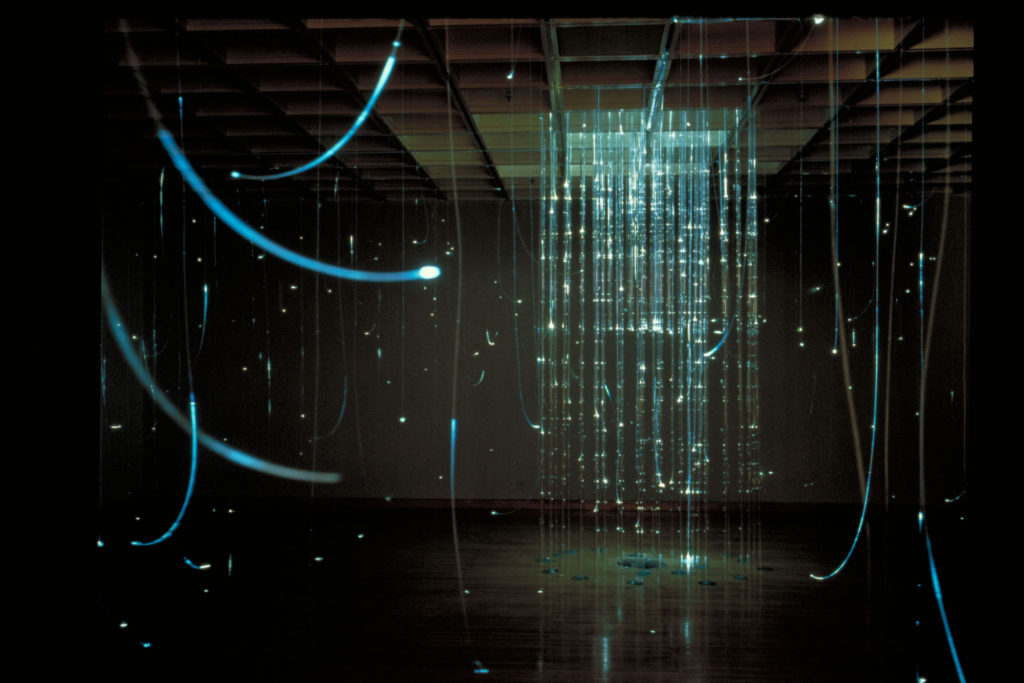
MAD Museum, New York, NY 1993
Walking into a living drawing
Critic and MAD museum curator John Perrault invited me to be in the Glass Installations show. There were four men and me. John said, “I know you want the biggest space, Mary.” True, I did.
We all arrived to install. The men brought big crates, workers, and machinery. I arrived with an old-style folding luggage cart holding a small box. The ceiling was a dropped wooden lattice in a grid pattern. I ran fiber optics along the square grids and scraped the edges of the fiber optics so the lines would emit light. In the center of the, gallery, I placed clear glass tubes in a circular pattern; within that circle, I placed a smaller circle, not touching the ground, so a person could imagine fitting under it. Below the tubes were “puddles” of glass as if the center structure were melting. Along the walls, I drew lines mimicking the flowing lines of the hanging fiberoptics.
I wanted viewers to experience two things. The first was to feel as though they were walking into a living drawing. The second was to imagine themselves in the center circle. Just as children find little secret hiding places in the woods, under furniture, in bushes, I wanted viewers to imagine themselves in the center circle and to look at the magic of the room pulsating with light as the fiberoptic lines appeared and then disappeared in random order. It was all white light. The room felt magical and spacious.
Light Wall


Lannan Museum, Palm Beach, FL 1994
Walking into a living painting
Entering “Light-Wall,” an installation at the Lannan Museum, is like walking into a painting. Painter Maiya Keck painted Day-Glo flowers on the wall. On these flowers, I stapled fiber optics that would glow and change color rapidly. The brilliant reflective color at the entrance of this long narrow room fades into pure white light in the adjacent second room.
Walking into what appears to be a flat surface transforms your sense of space. Light pulsates in a frenetic way through wild veins in the ceiling and then is carried down through meandering glass tubes. In a recessed area, fine flickering points of light transport you further into deep space, where you feel that you are floating, and you lose your earthbound orientation and sense of time.




